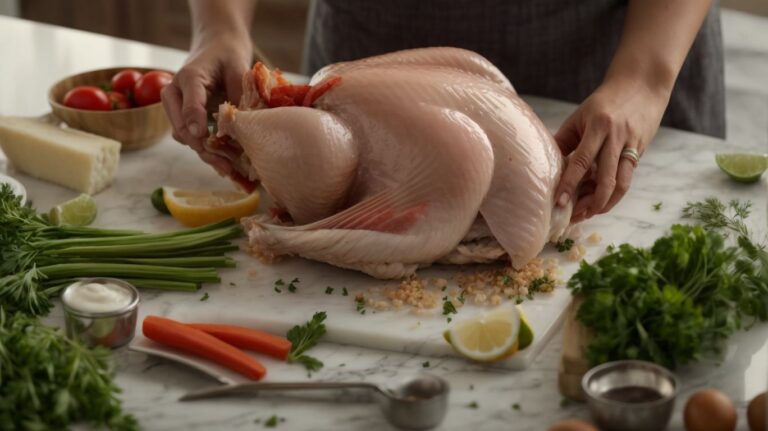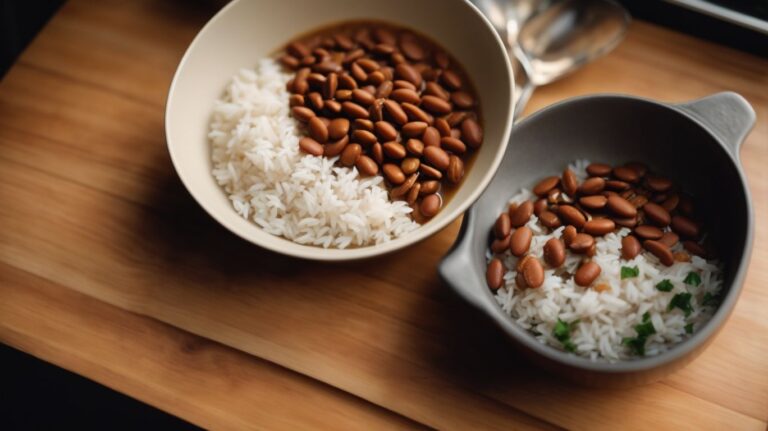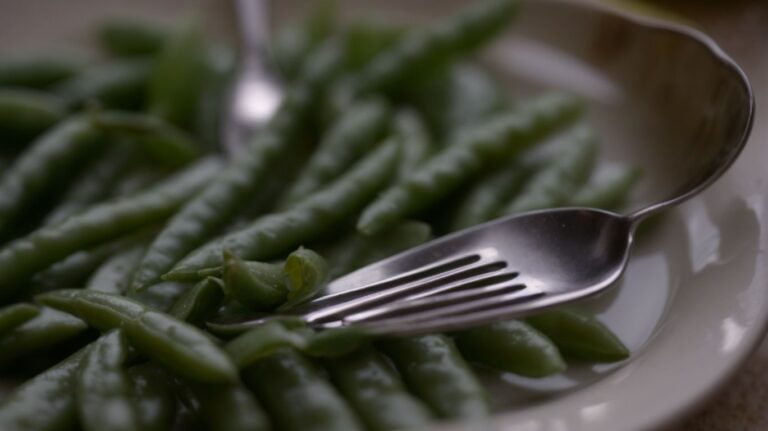How to Cook Udon Noodles for Soup?
Are you a fan of Japanese cuisine or looking to expand your culinary skills?
Udon noodles are a versatile and delicious option to add to your repertoire.
In this article, we will explore the origin and history of udon noodles, discuss their nutritional value, and delve into the various types available.
We will also provide a step-by-step guide on how to cook udon noodles for soup, along with tips for achieving perfectly cooked noodles every time.
So, grab your apron and let’s get cooking!
Key Takeaways:
What are Udon Noodles?
Udon Noodles are a traditional Japanese dish known for their chewy texture and comforting appeal.
Originating in Japan during the Nara period (710-794 AD), Udon Noodles have been a beloved staple in Japanese cuisine for centuries. These thick wheat flour noodles are typically served in a savory broth, often made from dashi, soy sauce, and mirin. Udon is renowned for its simplicity in preparation, making it a versatile comfort food enjoyed by people of all ages.
Throughout Japan, various regional specialties of Udon Noodles can be found, each with its unique twist on the classic dish. Some popular variations include Kitsune Udon topped with fried tofu, Tempura Udon with crispy tempura pieces, and Niku Udon featuring sliced meat.
To make Udon Noodles from scratch, a dough of wheat flour, salt, and water is kneaded, rolled out, and cut into thick strands. These noodles are then boiled until they achieve the desired chewy texture and served hot in a steaming bowl of broth with toppings of choice.
Origin and History of Udon Noodles
The Origin and History of Udon Noodles trace back to regions like Sanuki in Japan, where this traditional dish has been prepared using authentic methods for generations.
Udon Noodles hold a special place in Japanese cuisine, reflecting the country’s rich culinary heritage. The use of simple ingredients like wheat flour, water, and salt underscores the elegance and simplicity of this beloved staple.
Traditional preparation involves kneading the dough to achieve the perfect texture, followed by a resting period to allow the gluten to develop fully.
The noodles are then cut into thick strips, creating the iconic shape that is synonymous with Udon. The cooking process typically involves boiling the noodles until they reach a chewy yet tender consistency.
Nutritional Value of Udon Noodles
The Nutritional Value of Udon Noodles lies in their simple yet wholesome ingredients, making them a popular choice for quick homemade meals.
Udon Noodles are primarily made from wheat flour, water, and salt, creating a chewy and satisfying texture that pairs well with various flavors. What sets them apart is their versatility – they can be enjoyed in hot broths, stir-fries, or chilled salads, adapting to different culinary styles. Whether you prefer a traditional Japanese prep with dashi broth or a modern fusion dish with vegetables and proteins, Udon Noodles serve as a blank canvas for culinary creativity.
Types of Udon Noodles
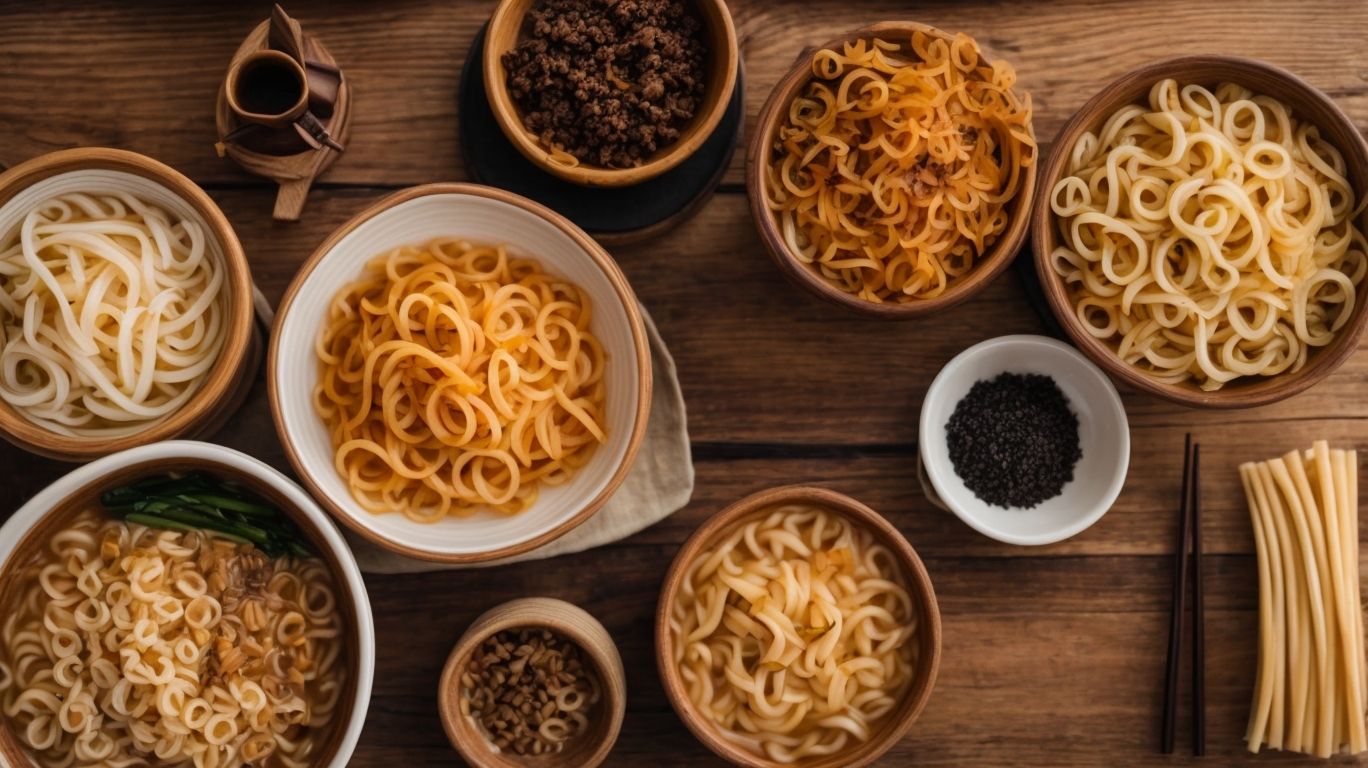
Credits: Poormet.Com – Adam Young
Udon Noodles come in various types, including Fresh, Dried, and Frozen varieties, each offering unique textures and flavors.
Starting with Fresh Udon Noodles, these are characterized by their soft and chewy texture, providing a delightful bite in soups and stir-fries. They are often handmade and have a subtle wheat flavor that shines through in dishes.
On the other hand, Dried Udon Noodles are convenient and have a denser texture once cooked, making them great for absorbing flavors in broth-based dishes. They tend to be more shelf-stable and are a pantry staple in many households.
Frozen Udon Noodles are pre-cooked and frozen to preserve their freshness, requiring a quick boil before use, and they retain a springy texture, perfect for quick meals that need a hearty base.
Fresh Udon Noodles
Fresh Udon Noodles are prized for their chewy texture and delightful mouthfeel, making them a popular choice for noodle enthusiasts.
The unique chewiness of Fresh Udon Noodles is due to their dough being kneaded in a specific way that creates a dense yet springy consistency when cooked. They boast a freshness that sets them apart, often found refrigerated rather than dried, enhancing their flavor and texture. This freshness adds a delightful softness to the noodles, making each bite a satisfying experience.
Versatile in nature, Fresh Udon Noodles can be featured in a myriad of dishes, from traditional Japanese soups like tempura udon to stir-fries or even cold noodle salads. When cooking Fresh Udon Noodles, it is crucial to boil them for only a few minutes to preserve their chewiness and prevent them from becoming mushy. Properly cooked Udon Noodles should remain firm and slightly chewy.
Dried Udon Noodles
Dried Udon Noodles are a convenient pantry staple known for their long shelf life and ease of cooking using traditional methods.
These noodles are made from a simple combination of wheat flour, salt, and water, offering a chewy and springy texture when cooked to perfection. The beauty of Dried Udon Noodles lies in their versatility, as they can be used in a myriad of dishes, from soothing soups to flavorful stir-fries.
When preparing Dried Udon Noodles, simply bring a pot of water to a boil and add the noodles. Cook them for about 8-10 minutes until they reach the desired softness, stirring occasionally to prevent clumping. Once cooked, drain the noodles and rinse them under cold water to stop the cooking process and maintain their ideal consistency.
Frozen Udon Noodles
Frozen Udon Noodles offer a convenient option for quick meals, allowing for easy customization with a variety of toppings and flavors.
One of the key advantages of Frozen Udon Noodles is their long shelf life, making them ideal for stocking up in the freezer for days when you need a speedy meal solution. The convenience of having udon noodles readily available at any time saves you from last-minute grocery trips. These noodles are versatile and can be used in various dishes beyond traditional Japanese cuisine.
When preparing Frozen Udon Noodles, consider boiling them for a few minutes until they are tender yet firm, ensuring they don’t become mushy. To enhance their flavor profile, you can add soy sauce, sesame oil, or mirin to the cooking water for an extra depth of taste. Experimenting with different toppings such as sliced green onions, grilled chicken, or sesame seeds can elevate the dish and cater to your personal preferences.
How to Cook Udon Noodles for Soup?
Cooking Udon Noodles for Soup involves preparing the right ingredients, boiling the noodles to perfection, and adding flavorful toppings for a satisfying meal.
To start, select high-quality Udon Noodles that are fresh and have a good texture. In a pot, bring water to a boil and add the noodles, stirring occasionally to prevent sticking. Cook the noodles according to the package instructions until they are tender but still slightly firm. Once cooked, drain the noodles and rinse them under cold water to stop the cooking process and remove excess starch.
Next, prepare the soup broth by combining dashi stock, soy sauce, mirin, and a touch of sugar in a separate pot. Bring the broth to a simmer over medium heat, allowing the flavors to meld together.
Assemble the dish by placing the cooked Udon Noodles in a serving bowl and ladling the hot soup over them. Top the noodles with sliced scallions, nori seaweed, soft-boiled egg, and a sprinkle of sesame seeds for added flavor and texture. Enjoy your delicious bowl of Udon Noodle Soup!
Preparing the Ingredients
Preparing the Ingredients for Udon Noodle Soup involves gathering fresh produce, aromatic spices, and flavorful broths to create a vegan-friendly culinary delight.
When selecting your produce, opt for vibrant, colorful vegetables like bok choy, shiitake mushrooms, and carrots to add both flavor and visual appeal to your dish.
For the traditional broth base, a combination of miso paste, soy sauce, and seaweed will impart that umami-rich taste characteristic of authentic Udon noodle soup.
Don’t forget to season your soup with a dash of sesame oil for a nutty aroma and a sprinkle of fresh green onions for that extra burst of freshness and color.
Boiling the Noodles
Boiling the Udon Noodles requires precision in time and temperature control to achieve the desired consistency, whether serving the noodles hot or cold.
When boiling Udon noodles, it is crucial to bring the water to a vigorous boil before adding the noodles, as this helps to prevent them from sticking together. The ideal cooking time typically ranges from 8 to 12 minutes, depending on the thickness of the noodles. Test for doneness by sampling a noodle for the desired firmness. To maintain the perfect texture, immediately rinse the noodles under cold water after cooking to stop the cooking process. This step is especially important when preparing cold Udon noodle dishes, as it helps to retain their chewy texture.
Draining and Rinsing the Noodles
Draining and Rinsing the Udon Noodles post-cooking helps in achieving the desired texture and removing excess starch for a perfect bowl of noodles.
Properly draining and rinsing Udon Noodles is key to prevent them from becoming mushy and clumping together. By rinsing in cold water immediately after cooking, you halt the cooking process and prevent overcooking. This step also helps in enhancing the texture of the noodles, making them springy and firm.
One method is to use a fine mesh strainer to drain the noodles quickly and efficiently. Another effective technique is to swirl the noodles in the strainer under running water to ensure thorough rinsing.
Adding the Noodles to the Soup
Adding the Udon Noodles to the Soup marks the final step in creating a delightful dish, allowing for the incorporation of traditional toppings and flavorful soy sauce.
Once the noodles are added to the steaming broth, it’s time to enhance the dish with a variety of toppings that bring depth and texture to each spoonful.
- Common traditional toppings include sliced scallions
- tender bamboo shoots
- crispy tempura flakes
- hearty slices of fish cake
For a touch of umami, a drizzle of soy sauce adds savory richness to the soup, balancing the flavors beautifully.
To cater to different preferences, consider offering additional garnishes like:
- sesame seeds
- nori seaweed strips
- a dollop of spicy chili paste for those who enjoy a kick of heat
Tips for Perfectly Cooked Udon Noodles
Achieving Perfectly Cooked Udon Noodles requires attention to detail in cooking time, water proportions, and testing for doneness to ensure a satisfying dining experience.
When cooking Udon noodles, the ideal cooking time usually ranges between 8-12 minutes, depending on the thickness of the noodles. It’s crucial to follow the package instructions but also test for readiness by tasting a strand for texture.
Ensuring the water level in the pot is sufficient to cover the noodles completely helps in their even cooking. Use a large pot to prevent overcrowding, allowing the noodles to move freely while boiling.
If you encounter sticky or clumpy noodles, try rinsing them briefly under cold water after cooking to remove excess starch. This can help in achieving a smoother texture and prevent them from sticking together.
Cooking Time and Temperature
The Cooking Time and Temperature play a vital role in determining the ideal texture and firmness of Udon Noodles, ensuring they are served in the perfect bowl.
Udon noodles, a staple in Japanese cuisine, are known for their chewy and slippery texture. Regarding cooking these noodles, the timing and temperature are crucial factors that can make or break the dish.
Overcooking can result in mushy noodles, while undercooking can leave them too firm and unappetizing. Achieving the perfect chewiness involves precise control over both the cooking time and the water temperature.
To achieve the desired consistency, it is recommended to follow the instructions on the packaging as a general guideline. Personal preferences vary, so feel free to experiment with adjustments. If you prefer softer noodles, consider increasing the cooking time slightly while maintaining the temperature constant. On the other hand, for firmer noodles, reduce the cooking time accordingly. It’s a delicate balance that can significantly impact the overall dining experience.
Using the Right Amount of Water
Using the Right Amount of Water is crucial for cooking Udon Noodles with the desired texture and achieving an easy preparation process.
Regarding cooking Udon Noodles, the water quantity plays a fundamental role in the final dish’s outcome. The amount of water used directly affects the texture of the noodles – too little can result in overly sticky or chewy noodles, while too much water can leave them soggy and lackluster in taste. To ensure that your Udon Noodles turn out just right, it’s essential to strike a balance in the water ratio.
- In terms of consistency, the ideal water level should allow the noodles to cook evenly without clumping together or becoming too mushy.
- Adjusting the water levels can significantly impact the overall cooking ease. By fine-tuning the amount of water based on the thickness and quantity of noodles, you can streamline the cooking process and achieve a harmonious balance of flavors and textures.
One practical tip is to start by adding a bit less water than recommended in the recipe and gradually adjust as needed. This method gives you more control over the cooking process and helps you tailor the noodles to your preferred level of doneness. Remember, mastering the art of water measurement can elevate your Udon Noodle dish from ordinary to extraordinary!
Stirring the Noodles
Stirring the Noodles during the cooking process aids in preventing clumping, ensuring even cooking, and enhancing the absorption of flavorful broth.
When you stir Udon Noodles as they cook, you allow the noodles to separate, preventing them from sticking together and forming clumps. This gentle movement through the broth or sauce also ensures that all parts of the noodles receive equal exposure to heat, resulting in consistent texture and doneness.
By stirring the noodles, you encourage them to soak up the delectable flavors from the soup or sauce they are simmering in. This enhances the overall taste and creates a harmonious blend between the noodles and the broth.
To make the most out of this technique, it’s advisable to stir the noodles gently and periodically, using chopsticks or a wooden spoon. This method not only promotes even cooking but also helps in maintaining the integrity of the noodles.
Testing for Doneness
Testing for Doneness in Udon Noodles involves checking for the desired chewy texture and readiness, ensuring they are perfectly suited for hot soups and cold dishes alike.
One reliable method to determine if the udon noodles are perfectly cooked is by using the visual cues. Cooked udon noodles should appear plump and slightly translucent. Another key indicator is the color change from a raw white to a more opaque white or yellowish hue. Sensory cues are crucial too; gently pinch a strand of noodle to feel for a slight resistance or ‘bite’. This indicates they are cooked al dente, ready to be incorporated into your culinary creations.
Conclusion
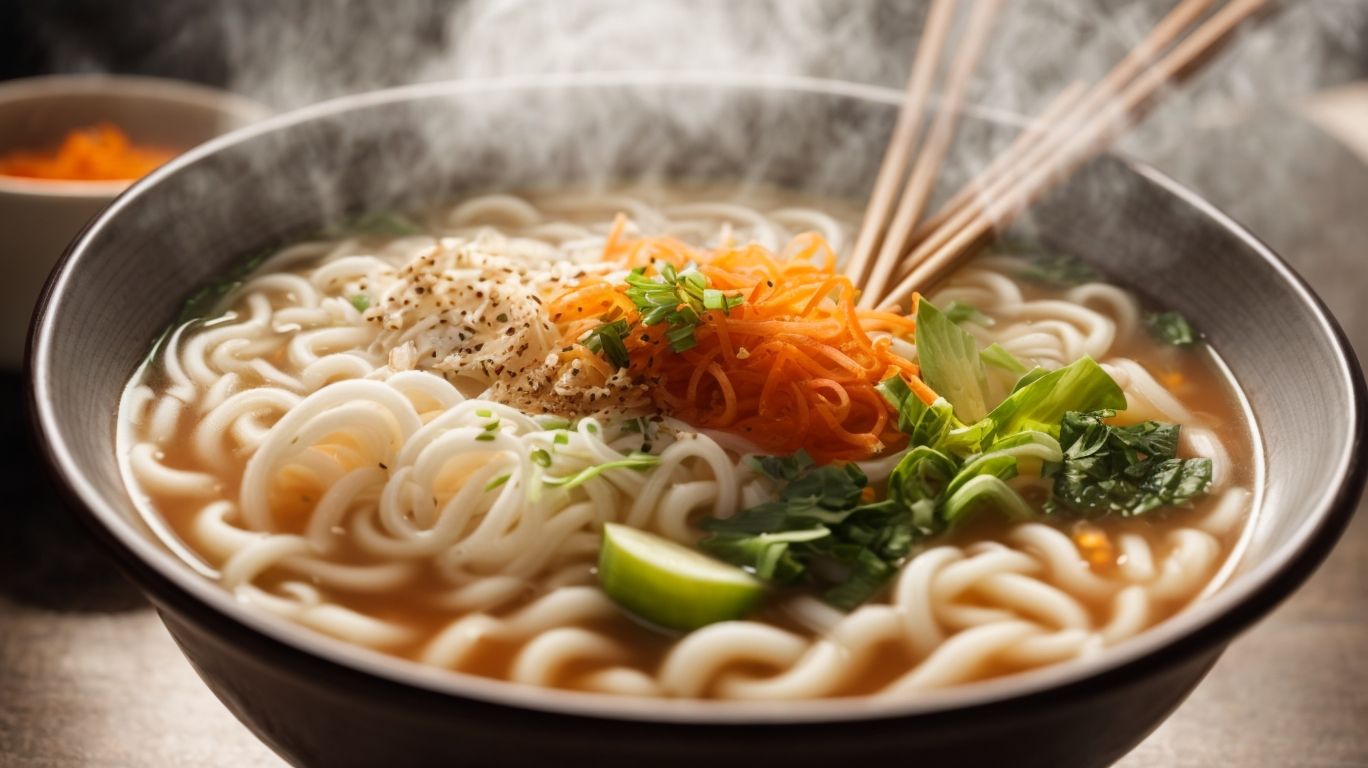
Credits: Poormet.Com – Scott Nelson
In conclusion, Udon Noodles offer a versatile canvas for culinary creativity, with endless variations and recipes to explore and enjoy.
These thick wheat noodles, originating from Japan, can be enjoyed in a comforting hot broth with vegetables, meat, or seafood, creating a heartwarming meal on a chilly evening.
On the other hand, chilled Udon Noodles tossed in a savory sauce make a refreshing summer dish, perfect for warm days.
The beauty of Udon lies in its ability to absorb flavors and meld effortlessly with different ingredients, whether it’s in traditional Japanese broths or fusion dishes with a twist.
Frequently Asked Questions
What are udon noodles and how are they different from other types of noodles?
Udon noodles are a type of thick, wheat-based Japanese noodle. They are larger and chewier than other noodles, making them perfect for soups and stir-fries.
How do I properly cook udon noodles for soup?
The best way to cook udon noodles for soup is to boil them in a pot of water for about 8-10 minutes, or until they are soft and fully cooked. Be sure to drain and rinse them with cold water to prevent them from sticking together.
Can I use frozen udon noodles for soup?
Yes, you can use frozen udon noodles for soup. Just be sure to thaw them completely before cooking so they don’t clump together. You may also need to adjust the cooking time since frozen noodles may take longer to cook.
What types of broth are best for udon noodle soup?
The most traditional broth for udon noodle soup is dashi, a Japanese broth made from bonito flakes and kelp. However, you can also use other types of broth such as chicken or vegetable broth for a different flavor.
How can I add more flavor to udon noodle soup?
To enhance the flavor of your udon noodle soup, you can add ingredients such as soy sauce, miso paste, sesame oil, or chili paste. You can also add toppings like green onions, seaweed, or sliced meat for added flavor and texture.
Can I make a vegetarian or vegan udon noodle soup?
Yes, you can make a vegetarian or vegan udon noodle soup by using vegetable broth and omitting any meat or animal-based ingredients. You can also add tofu or other plant-based protein for a filling and nutritious soup.


